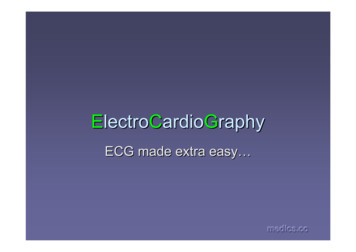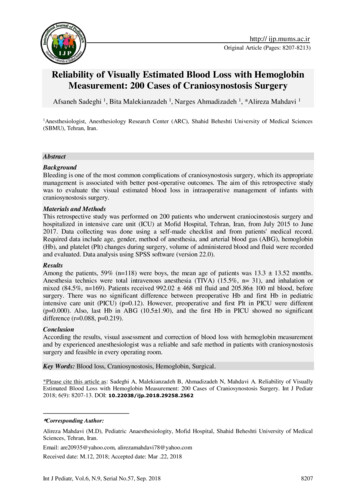
Transcription
ElectroCardioGraphyECG made extra easy medics.ccmedics.cc
Overview Objectives for this tutorial What is an ECG? Overview of performingelectrocardiography on a patient Simple physiology Interpreting the ECGmedics.ccmedics.cc
ObjectivesBy the end of this tutorial the student should be able to: State a definition of electrocardiogram Perform an ECG on a patient, including explaining to the patientwhat is involved Draw a diagram of the conduction pathway of the heart Draw a simple labelled diagram of an ECG tracing List the steps involved in interpreting an ECG tracing in an orderlyway Recite the normal limits of the parameters of various parts of theECG Interpret ECGs showing the following pathology: MI, AF, 1st 2nd and 3rd degree heart block, p pulmonale, p mitrale, WolffParkinson-White syndrome, LBBB, RBBB, Left and Right axis deviation,LVH, pericarditis, Hyper- and hypokalaemia, prolonged QT.medics.ccmedics.cc
What is an ECG?ECG ElectrocardiogramTracing of heart’s electrical activitymedics.ccmedics.cc
Recording an ECGmedics.ccmedics.cc
Overview of procedure GRIP Greet, rapport, introduce,identify, privacy, explainprocedure, permission Lay patient down Expose chest, wrists,ankles Clean electrode sites May need to shave Turn on machine Calibrate to 10mm/mV Rate at 25mm/s Record and print Label the tracing Name, DoB, hospitalnumber, date andtime, reason forrecording Disconnect if Apply electrodesadequate and remove Attach wires correctlyelectrodesmedics.ccmedics.cc
Electrode placement 10 electrodes in total are placed on thepatient Firstly self-adhesive ‘dots’ are attached tothe patient. These have single electricalcontacts on them The 10 leads on the ECG machine arethen clipped onto the contacts of the ‘dots’medics.ccmedics.cc
Electrode placement in 12 leadECG 6 are chest electrodes Called V1-6 or C1-6 4 are limb electrodes Right armLeft armLeft legRight legRideYourGreenBike Remember The right leg electrodeis a neutral or “dummy”!medics.ccmedics.cc
Electrode placementFor the chest electrodes V1 4th intercostal space right sternal edge V2 4th intercostal space left sternal edge (to find the 4th space, palpate the manubriosternal angle (ofLouis) Directly adjacent is the 2nd rib, with the 2nd intercostal spacedirectly below. Palpate inferiorly to find the 3rd and then 4thspace V4 over the apex (5th ICS mid-clavicularline) V3 halfway between V2 and V4 V5 at the same level as V4 but on theanterior axillary line V6 at the same level as V4 and V5 but onthe mid-axillary linemedics.ccmedics.cc
Recording the trace Different ECG machines have different buttonsthat you have to press. Ask one of the staff on the ward if it is a machinethat you are unfamiliar with. Ask the patient to relax completely. Any skeletalmuscle activity will be picked up as interference. If the trace obtained is no good, check that allthe dots are stuck down properly – they have atendency to fall off.medics.ccmedics.cc
Electrophysiologymedics.ccmedics.cc
Electrophysiology Pacemaker sinoatrial node Impulse travels across atria Reaches AV node Transmitted along interventricular septum in Bundle ofHis Bundle splits in two (right and left branches) Purkinje fibresmedics.ccmedics.cc
Overalldirectionofcardiacimpulsemedics.ccmedics.cc
How does the ECG work? Electrical impulse (wave of depolarisation) picked up byplacing electrodes on patient The voltage change is sensed by measuring the currentchange across 2 electrodes – a positive electrode and anegative electrode If the electrical impulse travels towards the positiveelectrode this results in a positive deflection If the impulse travels away from the positive electrodethis results in a negative deflectionmedics.ccmedics.cc
Away fromtheelectrodeTowardstheelectrode negativedeflection positivedeflectionDirection of impulse (axis)medics.ccmedics.cc
Types of Leads Coronal plane (Limb Leads)1. Bipolar leads — l , l l , l l l2. Unipolar leads — aVL , aVR , aVF Transverse planeV1 — V6 (Chest Leads)medics.ccmedics.cc
Electrodes around the heart
LeadsHow are the 12 leads on theECG (I, II, III, aVL, aVF,aVR, V1 – 6) formedusing only 9 electrodes(and a neutral)?-Lead I Lead I is formed using theright arm electrode (red)as the negative electrodeand the left arm (yellow)electrode as the positivemedics.ccmedics.cc
Leads-Lead I medics.ccmedics.cc
Leads Lead II is formedusing the right armelectrode (red) as thenegative electrodeand the left legelectrode as thepositiveLead IImedics.ccmedics.cc
Lead IImedics.ccmedics.cc
Leads Lead III is formed using the left armelectrode as the negative electrode andthe left leg electrode as the positive aVL, aVF, and aVR are composite leads,computed using the information from theother leadsmedics.ccmedics.cc
Leads and what they tell youLimb leadsLimb leads look at the heart in the coronalplane aVL, I and II lateral II, III and aVF inferior aVR right side of the heartmedics.ccmedics.cc
Leads look at the heart fromdifferent directionsaxis
Leads and what they tell youEach lead can be thought of as ‘looking at’ an areaof myocardiumChest leadsV1 to V6 ‘look’ at the heart on the transverse plain V1 and V2 look at the anterior of the heart and Rventricle V3 and V4 anterior and septal V5 and V6 lateral and left ventriclemedics.ccmedics.cc
Elements of the tracemedics.ccmedics.cc
What do the componentsrepresent? P wave atrial depolarisation QRS ventricular depolarisation T repolarisation of theventriclesmedics.ccmedics.cc
Interpreting the ECGmedics.ccmedics.cc
Interpreting the ECG Check NameDoBTime and dateIndication e.g. “chest pain” or “routine pre-op”Any previous or subsequent ECGsIs it part of a serial ECG sequence? In which case it may benumberedCalibrationRateRhythmAxisElements of the tracing in each leadmedics.ccmedics.cc
CalibrationCheck that your ECG is calibrated correctlyHeight 10mm 1mV Look for a reference pulse which should be therectangular looking wave somewhere near theleft of the paper. It should be 10mm (10 smallsquares) tallPaper speed 25mm/s 25 mm (25 small squares / 5 large squares)equals one secondmedics.ccmedics.cc
Rate If the heart rate is regular Count the number of large squares betweenR waves i.e. the RR interval in large squares Rate 300RRe.g. RR 4 large squares300/4 75 beats per minutemedics.ccmedics.cc
RateIf the rhythm is irregular (see next slide on rhythmto check whether your rhythm is regular or not) itmay be better to estimate the rate using therhythm strip at the bottom of the ECG (usuallylead II)The rhythm strip is usually 25cm long (250mm i.e.10 seconds)If you count the number of R waves on that stripand multiple by 6 you will get the ratemedics.ccmedics.cc
RhythmIs the rhythm regular? The easiest way to tell is to take a sheet of paper and line up oneedge with the tips of the R waves on the rhythm strip. Mark off on the paper the positions of 3 or 4 R wave tips Move the paper along the rhythm strip so that your first mark linesup with another R wave tip See if the subsequent R wave tips line up with the subsequentmarks on your paper If they do line up, the rhythm is regular. If not, the rhythm is irregularmedics.ccmedics.cc
RhythmSinus Rhythm DefinitionCardiac impulse originates from thesinus node. Every QRS must bepreceded by a P wave. (This does not mean that every P wave must befollowed by a QRS – such as in 2nd degree heartblock where some P waves are not followed by aQRS, however every QRS is preceded by a P waveand the rhythm originates in the sinus node, hence itis a sinus rhythm. It could be said that it is not anormal sinus rhythm)medics.ccmedics.cc
RhythmSinus arrhythmia There is a change in heart rate depending on the phase ofrespiration Q. If a person with sinus arrhythmia inspires, what happens to theirheart rate? A. The heart rate speeds up. This is because on inspiration there isa decrease in intrathoracic pressure, this leads to an increasedvenous return to the right atrium. Increased stretching of the rightatrium sets off a brainstem reflex (Bainbridge’s reflex) that leads tosympathetic activation of the heart, hence it speeds up) This physiological phenomenon is more apparent in children andyoung adultsmedics.ccmedics.cc
RhythmSinus bradycardia Rhythm originates in the sinus node Rate of less than 60 beats per minuteSinus tachycardia Rhythm originates in the sinus node Rate of greater than 100 beats per minutemedics.ccmedics.cc
Axis The axis can be though of as the overalldirection of the cardiac impulse or wave ofdepolarisation of the heart An abnormal axis (axis deviation) can givea clue to possible pathologymedics.ccmedics.cc
Axisor extremeaxisdeviationright axisdeviationAn axis fallingoutside the normalrange can be leftaxis deviationA normal axiscan lieanywherebetween -30and 90degreesor 120degreesaccording tosome
Axis deviation - Causes Wolff-Parkinson-Whitesyndrome can cause both Leftand Right axis deviationA useful mnemonic: “RAD RALPH the LAD fromVILLA” Right Axis Deviation Right ventricular hypertrophy Anterolateral MI Left Posterior Hemiblock Left Axis Deviation Ventricular tachycardiaInferior MILeft ventricular hypertrophyLeft Anterior hemiblockmedics.ccmedics.cc
The P waveThe P wave represents atrialdepolarisationIt can be thought of as beingmade up of two separatewaves due to right atrialdepolarisation and left atrialdepolarisation.Which occurs first?Right atrial depolarisationSum ofright andleft wavesright atrial depolarisationleft atrial depolarisationmedics.ccmedics.cc
The P waveDimensions No hard and fast rulesHeight a P wave over 2.5mm should arouse suspicionLength a P wave longer than 0.08s (2 small squares) shouldarouse suspicionmedics.ccmedics.cc
The P waveHeight A tall P wave (over2.5mm) can be called Ppulmonale Occurs due to R atrialhypertrophy Causes include:normalP pulmonale 2.5mm pulmonary hypertension, pulmonary stenosis tricuspid stenosismedics.ccmedics.cc
The P waveLength A P wave with a length 0.08 seconds (2 smallsquares) and a bifidshape is called P mitrale It is caused by left atrialhypertrophy and delayedleft atrial depolarisationnormalP mitrale Causes include: Mitral valve diseaseLVHmedics.ccmedics.cc
The PR interval The PR interval is measured between thestart of the P wave to the start of the QRScomplex (therefore if there is a Q wave before the Rwave the PR interval is measured from thestart of the P wave to the start of the Qwave, not the start of the R wave)medics.ccmedics.cc
The PR interval The PR interval corresponds to the timeperiod between depolarisation of the atriaand ventricular depolarisation. A normal PR interval is between 0.12 and0.2 seconds ( 3-5 small squares)medics.ccmedics.cc
The PR interval If the PR interval is short (less than 3 smallsquares) it may signify that there is an accessoryelectrical pathway between the atria and theventricles, hence the ventricles depolarise earlygiving a short PR interval. One example of this is Wolff-Parkinson-Whitesyndrome where the accessory pathway iscalled the bundle of Kent. See next slide for ananimation to explain thismedics.ccmedics.cc
Depolarisation begins atthe SA nodeThe wave ofdepolarisation spreadsacross the atriaIt reaches the AV nodeand the accessory bundleConduction is delayed asusual by the in-built delayin the AV nodeHowever, the accessorybundle has no such delayand depolarisation beginsearly in the part of theventricle served by thebundleAs the depolarisation in this part of the ventricledoes not travel in the high speed conductionpathway, the spread of depolarisation across theventricle is slow, causing a slow rising delta waveUntil rapid depolarisationresumes via the normalpathway and a morenormalmedics.ccmedics.cccomplex follows
The PR interval If the PR interval is long ( 5 small squaresor 0.2s): If there is a constant long PR interval 1stdegree heart block is present First degree heart block is a longer thannormal delay in conduction at the AV nodemedics.ccmedics.cc
The PR interval If the PR interval looks as though it is wideningevery beat and then a QRS complex is missing,there is 2nd degree heart block, Mobitz type I.The lengthening of the PR interval insubsequent beats is known as the Wenckebachphenomenon (remember (w)one, Wenckebach, widens) If the PR interval is constant but then there is amissed QRS complex then there is 2nd degreeheart block, Mobitz type IImedics.ccmedics.cc
The PR interval If there is no discernable relationshipbetween the P waves and the QRScomplexes, then 3rd degree heart block ispresentmedics.ccmedics.cc
Heart block (AV node block)Summary 1st degree constant PR, 0.2 seconds 2nd degree type 1 (Wenckebach) PR widens over subsequent beats then a QRS is dropped 2nd degree type 2 PR is constant then a QRS is dropped 3rd degree No discernable relationship between p waves and QRScomplexesmedics.ccmedics.cc
The Q waveAre there any pathological Qwaves? A Q wave can be pathologicalif it is: Deeper than 2 small squares(0.2mV)and/or Wider than 1 small square(0.04s)and/or In a lead other than III or oneof the leads that look at theheart from the left (I, II, aVL,V5 and V6) where small Qs(i.e. not meeting the criteriaabove) can be normalNormal if dics.cc
medics.ccmedics.cc
The QRS height If the complexes in the chest leads lookvery tall, consider left ventricularhypertrophy (LVH) If the depth of the S wave in V1 added tothe height of the R wave in V6 comes tomore than 35mm, LVH is presentmedics.ccmedics.cc
QRS width The width of the QRS complex should be lessthan 0.12 seconds (3 small squares) Some texts say less than 0.10 seconds (2.5small squares) If the QRS is wider than this, it suggests aventricular conduction problem – usually right orleft bundle branch block (RBBB or LBBB)medics.ccmedics.cc
LBBB If left bundle branch blockis present, the QRScomplex may look like a‘W’ in V1 and/or an ‘M’shape in V6. New onset LBBB withchest pain considerMyocardial infarction Not possible to interpretthe ST segment.medics.ccmedics.cc
RBBB It is also called RSRpattern If right bundle branchblock is present, theremay be an ‘M’ in V1and/or a ‘W’ in V6. Can occur in healthypeople with normal QRSwidth – partial RBBBmedics.ccmedics.cc
QRS widthIt is useful to look at leads V1 and V6 LBBB and RBBB can be remembered by themnemonic: WiLLiaM MaRRoW Bundle branch block is caused either byinfarction or fibrosis (related to the ageingprocess)medics.ccmedics.cc
The ST segment The ST segment should sit on the isoelectric line It is abnormal if there is planar (i.e. flat) elevationor depression of the ST segment Planar ST elevation can represent an MI orPrinzmetal’s (vasospastic) angina Planar ST depression can represent ischaemiamedics.ccmedics.cc
Myocardial infarction Within hours: T wave may become peaked ST segment may begin to rise Within 24 hours: T wave inverts (may or may not persist)ST elevation begins to resolveIf a left ventricular aneurysm forms, ST elevation may persist Within a few days: pathological Q waves can form and usually persistmedics.ccmedics.cc
Myocardial infarction The leads affected determine the site ofthe infarct InferiorII, III, aVF Anteroseptal V1-V4 Anterolateral V4-V6, I, aVL PosteriorTall wide R and ST in V1and V2medics.ccmedics.cc
Acute Anterior MIST elevationmedics.ccmedics.cc
Inferior MIST elevationmedics.ccmedics.cc
The ST segment If the ST segment is elevated but slanted,it may not be significant If there are raised ST segments in most ofthe leads, it may indicate pericarditis –especially if the ST segments are saddleshaped. There can also be PR segmentdepressionmedics.ccmedics.cc
Pericarditismedics.ccmedics.cc
The T wave Are the T waves too tall? No definite rule for height T wave generally shouldn’tbe taller than half the sizeof the preceding QRS Causes: Hyperkalaemia Acute myocardialinfarctionmedics.ccmedics.cc
The T wave If the T wave is flat, it may indicatehypokalaemia If the T wave is inverted it may indicateischaemiamedics.ccmedics.cc
The QT interval The QT interval is measured from the start of theQRS complex to the end of the T wave. The QT interval varies with heart rate As the heart rate gets faster, the QT interval getsshorter It is possible to correct the QT interval withrespect to rate by using the following formula: QTc QT/ RR (QTc corrected QT)medics.ccmedics.cc
The QT interval The normal range for QTc is 0.38-0.42 A short QTc may indicate hypercalcaemia A long QTc has many causes Long QTc increases the risk of developingan arrhythmiamedics.ccmedics.cc
The U wave U waves occur after the T wave and areoften difficult to see They are thought to be due torepolarisation of the atrial septum Prominent U waves can be a sign ofhypokalaemia, hyperthyroidismmedics.ccmedics.cc
Supraventricular tachycardias These are tachycardias where the impulse is initiated inthe atria (sinoatrial node, atrial wall or atrioventricularnode) If there is a normal conduction pathway when theimpulse reaches the ventricles, a narrow QRS complexis formed, hence they are narrow complex tachycardias However if there is a conduction problem in theventricles such as LBBB, then a broad QRS complex isformed. This would result in a form of broad complextachycardiamedics.ccmedics.cc
medics.ccmedics.cc
Atrial FibrillationFeatures: There maybe tachycardia The rhythm is usually irregularly irregular No P waves are discernible – insteadthere is a shaky baseline This is because there is no order to atrialdepolarisation, different areas of atriumdepolarise at willmedics.ccmedics.cc
Atrial Fibrillationmedics.ccmedics.cc
medics.ccmedics.cc
Atrial flutter There is a saw-tooth baseline which rises above anddips below the isoelectric line. Atrial rate 250/min This is created by circular circuits of depolarisationset up in the atriamedics.ccmedics.cc
Ventricular Tachycardiamedics.ccmedics.cc
Ventricular Tachycardia QRS complexes are wide and irregular in shape Usually secondary to infarction Circuits of depolarisation are set up in damaged myocardiumThis leads to recurrent early repolarisation of theventricle leading to tachycardiaAs the rhythm originates in the ventricles, there is abroad QRS complexHence it is one of the causes of a broad complextachycardiaNeed to differentiate with supraventricular tachycardiawith aberrant conductionmedics.ccmedics.cc
Ventricular Fibrillationmedics.ccmedics.cc
Ventricular fibrillation Completely disordered ventriculardepolarisation Not compatible with a cardiac output Results in a completely irregular traceconsisting of broad QRS complexes ofvarying widths, heights and ratesmedics.ccmedics.cc
Elements of the tracingP wave Magnitude and shape, e.g. P pulmonale, P mitralePR interval (start of P to start of QRS) Normal 3-5 small squares,0.12-0.2sST segment Should be isoelectricT wave Magnitude and directionQT interval (Start QRS to end of T)Pathological Q waves?QRS complex Magnitude, duration andshape 3 small squares or 0.12sduration Normally 2 big squares or0.4s at 60bpm Corrected to 60bpm (QTc) QT/ RRintervalmedics.ccmedics.cc
Further work Check out the various quizzes / gamesavailable on the Imperial Intranet Get doctors on the wards to run through apatient’s ECG with youmedics.ccmedics.cc
medics.ccmedics.cc Objectives By the end of this tutorial the student should be able to: State a definition of electrocardiogram Perform an ECG on a patient, including explaining to the patient what is involved Draw a diagram of the conduction pathway of the heart Draw a simple labelled diagram of an ECG tracing List the steps involved in interpreting an ECG tracing in an orderly



